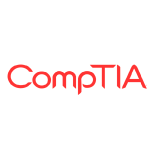COMPTIA NETWORK+ CERTIFICATION SUPPORT SKILLS(EXAM N10-007)
Course Overview
CompTIA Network+ helps develop a career in IT infrastructure covering troubleshooting, configuring, and managing networks.
This 5-day CompTIA Network + training course will teach you the fundamental principles of installing, configuring, and troubleshooting network technologies and help you to progress in a network administration career. It will prepare you to take the CompTIA Network+ N10-007 exam by providing complete coverage of the objectives and content examples listed on the syllabus. Study of the course can also help to prepare you for vendor-specific technical support qualifications and act as groundwork for more advanced training.

Course Objectives
In this course, you will install, configure, optimize, troubleshoot, repair, upgrade, and perform preventive maintenance on personal computers, digital devices, and operating systems. You will:
- Identify basic network theory concepts and major network communications methods
- Describe bounded network media
- Describe unbounded network media
- Identify the major types of network implementations
- Identify TCP/IP addressing and data delivery methods
- Analyze routing and switching technologies
- Identify the components of a TCP/IP implementation
- Analyze network security
- Implement network security
- Identify the components of a WAN implementation
- Identify the components used in cloud computing and virtualization
- Identify the components of a remote network implementation
- Manage networks
- Troubleshoot network issues
Course Prequisites
- Taken and passed both CompTIA A+ Certification exams or have 9-12 months knowledge and experience of IT administration
- Be able to configure and support PC, laptop, mobile (smartphone / tablet), and print devices
- Know basic network terminology and functions (such as Ethernet, TCP/IP, switches, routers)
- Configure and manage users, groups, and shared resources in a simple SOHO network
- Understand the use of basic access control measures, such as authentication, security policy, encryption, and firewalls
Target Audience
CompTIA Network+ is the first certification IT professionals specializing in network administration and support should earn. Network+ is aimed at IT professionals with job roles such as network administrator, network technician, network installer, help desk technician and IT cable installer.
Course Outline
Module 1 – Local Area Networks
Topologies and the OSI Model
- Key Features of Networks
- Network Topologies
- The OSI Model
- Physical Layer
- Data Link Layer
- Network Layer
- Transport Layer
- Upper Layers
- OSI Model Summary
- Labs
- VM Orientation
Ethernet
- Transmission Media
- Media Access Control
- Broadcast Domains
- Ethernet Frames
- Ethernet Deployment Standards
- MAC Addressing
- Address Resolution Protocol (ARP)
- Packet Sniffers
- Labs
- Configuring Ethernet Networking
Hubs, Bridges, and Switches
- Hubs and Bridges
- Switches
- Switch Interface Configuration
- Spanning Tree Protocol (STP)
- Power over Ethernet (PoE)
Infrastructure and Design
- Network Infrastructure Implementations
- Planning an Enterprise Campus Network
- Network Hierarchy and Distributed Switching
- Software Defined Networking
- Planning a SOHO Network
- TCP/IP Protocol Suite
Policies and Best Practices
- Procedures and Standards
- Safety Procedures
- Incident Response Policies
- Security and Data Policies
- Password Policy
- Employee Policies
Module 2 – IP Addressing
Internet Protocol
- IPv4
- IPv4 Address Structure
- Subnet Masks
- IP Routing Basics
- ipconfig / ifconfig
- ICMP and ping
- Labs
- Configuring IPv4 Networking
IPv4 Addressing
- IPv4 Addressing Schemes
- Classful Addressing
- Public versus Private Addressing
- Subnetting and Classless Addressing
- Planning an IPv4 Addressing Scheme
- Public Internet Addressing
- Variable Length Subnet Masks (VLSM)
- Labs
- Configuring IPv4 Subnets
IPv6 Addressing
- IPv6 Address Format
- IPv6 Addressing Schemes
- IPv6 Address Autoconfiguration
- Migrating to IPv6
- Labs
- Configuring IPv6 Networking
DHCP and APIPA
- IPv4 Address Autoconfiguration
- Configuring DHCP
- DHCPv6
- Labs
- Configuring Address Autoconfiguration
Module 3 – Internetworking
Routing
- Routing Basics
- Routing Algorithms and Metrics
- Dynamic Routing Protocols
- Administrative Distance and Route Redistribution
- IPv4 and IPv6 Internet Routing
- High Availability Routing
- Installing and Configuring Routers
- Routing Troubleshooting Tools
- Labs
- Configuring Routing
TCP and UDP
- Transmission Control Protocol (TCP)
- User Datagram Protocol (UDP)
- TCP and UDP Ports
- Port Scanners
- Protocol Analyzers
- Labs
- TCP and Port Scanning
Name Resolution and IPAM
- Host Names and FQDNs
- Domain Name System
- Configuring DNS Servers
- Resource Records
- Name Resolution Tools
- IP Address Management (IPAM)
- Labs
- Configuring Name Resolution and IPAM
Monitoring and Scanning
- Performance Monitoring
- Network Monitoring Utilities
- Logs and Event Management
- Simple Network Management Protocol
- Analyzing Performance Metrics
- Patch Management
- Vulnerability Scanning
- Labs
- Performance Testing and Monitoring
Network Troubleshooting
- Troubleshooting Procedures
- Identifying the Problem
- Establishing a Probable Cause
- Establishing a Plan of Action
- Troubleshooting Hardware Failure Issues
- Troubleshooting Addressing Issues
- Troubleshooting DHCP Issues
- Troubleshooting Name Resolution
- Troubleshooting Services
Module 4 – Applications and Security
Applications and Services
- TCP/IP Services
- HTTP and Web Servers
- SSL / TLS and HTTPS
- Email (SMTP / POP / IMAP)
- Voice Services (VoIP and VTC)
- Real-time Services Protocols
- Quality of Service
- Traffic Shaping
- Bottlenecks and Load Balancing
- Multilayer Switches
- Labs
- Configuring Application Protocols
Virtualization, SAN, and Cloud Services
- Virtualization Technologies
- Network Storage Types
- Fibre Channel and InfiniBand
- iSCSI
- Cloud Computing
- Configuring Cloud Connectivity
Network Security Design
- Security Basics
- Common Networking Attacks
- Network Segmentation and DMZ
- Virtual LANs (VLAN)
- VLAN Trunks
- Network Address Translation (NAT)
- Device and Service Hardening
- Honeypots and Penetration Tests
Network Security Appliances
- Basic Firewalls
- Stateful Firewalls
- Deploying a Firewall
- Configuring a Firewall
- Deploying a Proxy
- Intrusion Detection Systems (IDS)
- Denial of Service
- Labs
- Configuring a NAT Firewall
Authentication and Endpoint Security
- Authentication and Access Controls
- Social Engineering
- Authentication Technologies
- PKI and Digital Certificates
- Local Authentication
- RADIUS and TACACS+
- Directory Services
- Endpoint Security
- Network Access Control
- Labs
- Secure Appliance Administration
Module 5 – Operations and Infrastructure
Network Site Management
- Network Cabling Solutions
- Distribution Frames
- Change and Configuration Management
- Network Documentation and Diagrams
- Labeling
- Physical Security Devices
- Business Continuity and Disaster Recovery
- Network Link Management
- Power Management
- Backup Management
- Labs
- Network Inventory Management
Installing Cabled Networks
- Twisted Pair Cable (UTP / STP / ScTP)
- Twisted Pair Connectors
- Wiring Tools and Techniques
- Cable Testing Tools
- Troubleshooting Wired Connectivity
- Other Copper Cable Types
- Fiber Optic Cable and Connectors
- Transceivers and Media Converters
Installing Wireless Networks
- Wireless Standards (IEEE 802.11)
- Wireless Network Topologies
- Wireless Site Design
- Troubleshooting Wireless Connectivity
- Wireless Security
- Wi-Fi Authentication
- Extensible Authentication Protocol
- Troubleshooting Wireless Security
- Wireless Controllers
Installing WAN Links
- Wide Area Networks (WAN)
- Telecommunications Networks
- Modern Telecommunications Networks
- Local Loop Services
- Installing WAN Links
- Wireless WAN Services
- Internet of Things
Configuring Remote Access
- Remote Access Services (RAS)
- MPLS and PPP
- SIP Trunks
- Virtual Private Networks (VPN)
- SSL / TLS / DTLS VPNs
- IPsec
- Internet Key Exchange / ISAKMP
- Remote Access Servers
- Remote Administration Tools
- Managing Network Appliances
- Remote File Access
- Labs
- Configuring Secure Access Channels • Configuring a Virtual Private Network
What Our Students Have to Say


